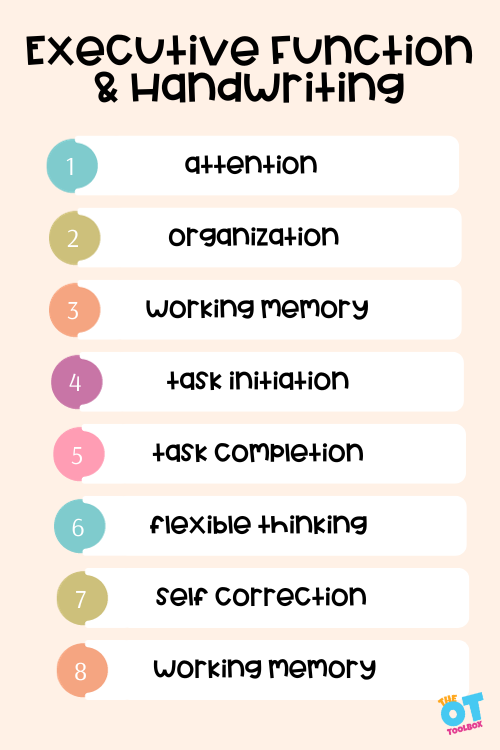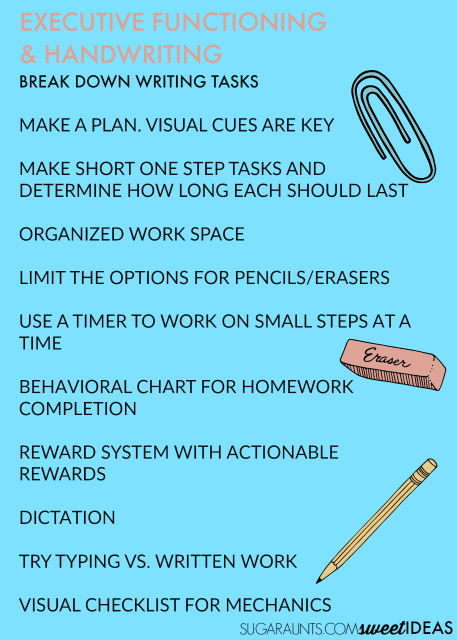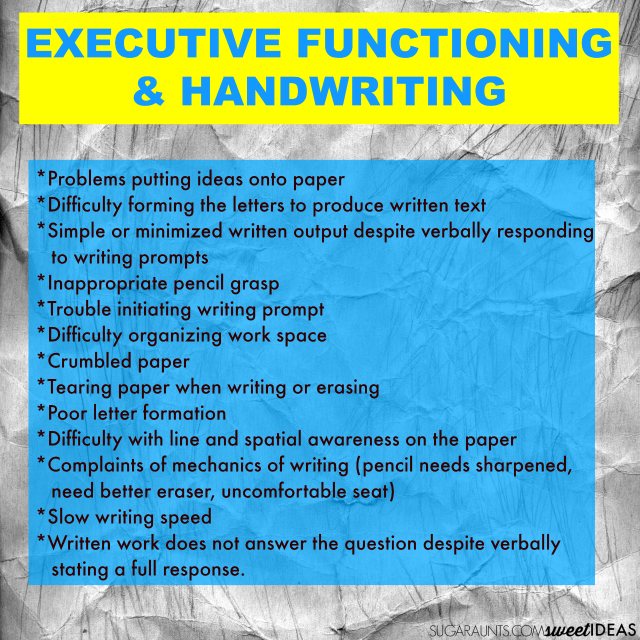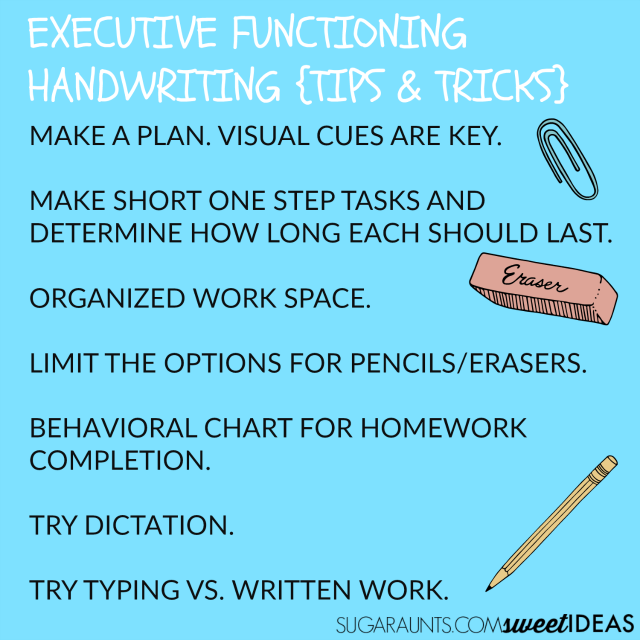Executive function and handwriting are deeply connected. In this blog post, we’re covering how executive function impacts handwriting and the ways to support handwriting by targeting critical thinking skills, including with efficiency. We’ve covered a wide variety of handwriting problems and executive functioning skills can impact these issues in a variety of ways.

Executive functioning skills are crucial for handwriting because they involve higher-order cognitive processes necessary for planning, organizing, initiating, and completing tasks. In the context of handwriting, these skills play a significant role in coordinating the various components involved in the writing process.
- Planning: Before starting to write, individuals need to plan and organize their thoughts. This includes considering the content, structure, and overall goal of the writing task. Research suggests that planning abilities are linked to the prefrontal cortex, a region associated with executive functions.
- Initiation: Initiating the writing process involves starting the task and maintaining focus. Difficulties in initiation can lead to procrastination or challenges in getting thoughts onto paper. In tasks throughout the day, including specific assignments, like completing a writing prompt or filling out a worksheet, initiation is a key component of executive functioning.
- Organization: Organizing information in a coherent and structured manner is essential for effective writing. This includes understanding sentence and paragraph structure.
- Working Memory: Working memory is the ability to hold and manipulate information in the mind while performing cognitive tasks. In handwriting, individuals need to recall and apply letter formations, spelling rules, and grammar.
- Self-Monitoring: Executive functions help individuals monitor and evaluate their own performance. In the context of handwriting, self-monitoring involves checking for spelling errors, proper letter formation, and overall legibility.
For children or individuals with challenges in executive functioning, difficulties in handwriting can arise. Occupational therapists often address these challenges by incorporating strategies to enhance executive functions, such as providing visual aids, breaking down tasks into smaller steps, and using mnemonic devices.
executive functioning and writing
Handwriting is a complex task. To write a sentence, a child needs to process information, recall important information, plan what he wants to write, initiate the writing task, perform the motor tasks to move the pencil to form letters, organize motor output on the page, manage paper/posture/pencil mechanics, realize errors, and be flexible enough to accept and correct mistakes.
Executive functioning skills can impact legible handwriting and a few tactics can support this area of need.
All of these “parts” of handwriting might sound familiar to the parent, teacher, or therapist of a child with executive function defects.
Executive function is our ability to “get things done”. It is a set of skills that allow us to organize information, plan, learn, multi-task, remember things, prioritize, pay attention, and act on information.

Handwriting for a child with executive functioning problems can be quite challenging.
Handwriting requires visual perception, sensory processing, cognitive components, motoric output, awareness of mistakes, and the ability to correct them just to complete written work.
All of this is involved with the ability to complete written tasks using executive functioning skills:
- Self-correcting errors
- Staying on task
- Starting or initiating written work (task initiation)
- Automaticity
- Flexible thinking
- Working memory
- Organization including organizing handwriting materials and thoughts
- Completing the task (task completion)
Now, image asking a child with executive function difficulties to write a 5 sentence writing prompt. After an 8 hour day of school. In the environment that the child feels most comfortable to exhibit behaviors (home with his loved ones)…it can be a messy scenario leading to a homework breakdown.

What is Executive Functioning?
One issue that may be causing a child to write well at school and produce completely illegible or totally sloppy written work at home is a deficit in executive functioning skills.
Kids who have trouble managing their executive functioning skills might have trouble with learning, organization, task completion, getting homework done, not losing their essential items, remembering to take their lunch box home each day, and so many other everyday tasks. Executive functioning is a set of mental skills that play a huge part in our daily tasks.
There are several mental processes (or critical thinking skills) involved in handwriting.
These essential mental tasks include:
- attention
- focus
- problem solving
- impulse control
- emotional control
- organization
- task initiation
- prioritizing and planning
- self-awareness
- working memory
- flexibility in thinking
This post contains affiliate links.
Executive Functioning Skills Checklist
So, when it comes to difficulties in the areas listed above, there are certain ways that we see those struggles come to life. In the child with executive functioning disorder or challenges in any one area of executive functioning, it can be helpful to have an executive functioning skills checklist, or list of ways that EF impacts writing. Here are some of the ways that you may see executive function impact writing.

Handwriting and Executive Function Skills
When asked to complete written work, a lack of executive functions or a inability to utilize executive functioning skills may occur. The child may show resistance to the writing topic, trouble initiating, and difficulties with written work output.
Here are signs of executive function problems in handwriting:
- Difficulty generating ideas
- Trouble articulating ideas
- Problems putting their ideas onto paper
- Difficulty forming the letters to produce written text
- Simple or minimized written output despite verbally responding to writing prompts
- Inappropriate pencil grasp
- Trouble initiating writing prompt
- Difficulty organizing work space
- Crumbled paper
- Tearing paper when writing or erasing
- Poor letter formation
- Difficulty with line and spatial awareness on the paper
- Slow writing speed
- Complaints of mechanics of writing (pencil needs sharpened, need better eraser, uncomfortable seat)
- Slow writing speed
- Written work does not answer the question or answers only part of the question despite verbally stating a full response.
- Repeats self in written work (in an open ended writing prompt type of task)

How to improve executive functioning skills and Handwriting
There are tips and supports that can support handwriting and executive functioning skills. These executive function tips can support written work in school or at home with homework. Try these strategies.
- Break down writing tasks. Separate an assignment into smaller parts.
- Make a plan. Visual cues are key. Use a highlighter and numbers to create a “to-do” list.
- Make short one step tasks and determine how long each should last.
- Consistency. Complete written work and homework in a specific place.
- Organized work space. Try these tips for organized homework.
- Materials in place. Limit the options for pencils/erasers.
- Use a timer to work on small steps at a time.
- Provide guidelines for written work.
- Mark off each task as it is completed.
- Behavioral chart for homework completion.
- Reward system with actionable rewards: Instead of a toy or sticker, a child can choose to earn earn time to stay up 15 minutes later on Friday, choose the family’s dessert for one day, or pick what to watch for family movie night.
- Dictation: Child dictates what he wants to write and parent/teacher/aide/another student completes the writing portion.
- Try typing vs. written work.
- Visual checklist for mechanics: Capitalization, punctuation, complete sentences, grammar, spelling, line awareness, spacing, letter formation.
This post is part of our Easy Quick Fixes to Better Handwriting series. Be sure to check out all of the easy handwriting tips in this month’s series and stop back often to see them all.
How to Improve Handwriting and Executive Function
One way to support students is through executive function coaching as a way to address specific needs using a coaching model.
One way to work on the handwriting issues that we commonly see, along with the executive functioning struggles is to combine these. Using checklists, or by drawing mind maps, and using visual cues, the child with executive functioning difficulties to “see” the big picture of what they need to accomplish.
The Impulse Control Journal does just that. It is a printable journal that kids (and teens or adults) can use to figure out what’s going on with attention, organization, planning, prioritization, and other mental skills. It can help them with areas like habits so they are able to accomplish the everyday tasks like planning out a chore or an assignment.
The Impulse Control Journal breaks down executive functioning…but it does it in easy and fun ways and doesn’t make the process overly distracting or overwhelming. Just pull out or print off the pages you need and use them over and over again. The best thing I love about this journal is the fact that the user is totally involved in the process. It’s not just making plans for the child (or teen/individual), but they have a real say in their situation and the ways to work on certain areas.
They are truly involved in the process of working on executive functioning skills.
And, the journal offers a way to work on handwriting with short lists, check boxes, mind maps, and more. So, by addressing the executive functioning skills and handwriting together, the process provides a real opportunity for change.

Colleen Beck, OTR/L has been an occupational therapist since 2000, working in school-based, hand therapy, outpatient peds, EI, and SNF. Colleen created The OT Toolbox to inspire therapists, teachers, and parents with easy and fun tools to help children thrive. Read her story about going from an OT making $3/hour (after paying for kids’ childcare) to a full-time OT resource creator for millions of readers. Want to collaborate? Send an email to contact@theottoolbox.com.







